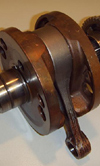Crankshaft Hardening
 In previous articles on the subject of crankshaft materials and hardening, we have made reference to the benefits of having residual compressive stress at the surface of the component. With the nitride hardening treatment used extensively on crankshafts, we not only make the crankshaft more wear resistant, but the change to the composition of the surface also imparts compressive residual stress. There are other methods of achieving this other than by nitriding the crankshaft, and we shall begin to look at these after examining a simple case to show the benefits of residual compressive stress.
In previous articles on the subject of crankshaft materials and hardening, we have made reference to the benefits of having residual compressive stress at the surface of the component. With the nitride hardening treatment used extensively on crankshafts, we not only make the crankshaft more wear resistant, but the change to the composition of the surface also imparts compressive residual stress. There are other methods of achieving this other than by nitriding the crankshaft, and we shall begin to look at these after examining a simple case to show the benefits of residual compressive stress.
If we imagine the case of a simple cylinder loaded in torsion, the shear stress increases linearly from zero at the centre of the bar, to a maximum at the surface. The magnitude of this stress is very easily calculated using the equations found in a university level textbook on engineering. The stress can be calculated for a wealth of more complex cases by referring to a book such as Roark’si.
This stress needs to be balanced against the significant strength of the material depending upon its use. In terms of a crankshaft, the significant strength is fatigue strength, which we must calculate for the case in hand based on the material, size of component, surface finish, service temperature and the correct stress concentration factor.
Returning to the simple cylindrical case, how do we factor the compressive stress into our information? We ‘add’ the stress due to our to our service load to give a level of stress which takes into account the stress field in the part prior to service loads. The stress field due to any process which puts compression into the surface layers necessarily puts the core into tension, and the ratio of the areas of the compressively stressed surface layers to the core area dictates the level of tension in the core. For a cylinder of significant dimensions relative to the stressed surface depth loaded in torsion, we don’t need to be worried too much about this effect, but should be wary when high tensile loads are applied. The high level of compressive surface stress means that the high stress due to torsion is mitigated to a large extent, and the fatigue life is markedly increased as a result.
In the case of crankshafts, we often find failures occur at the junction of the crankpins or main bearings with the crank webs. Generously proportioned fillets are essential, but not enough on their own without nitriding or additional processes. There may be circumstances where nitriding alone does not provide sufficient levels of compressive residual stress to allow a given design to work, and in these cases we need to look at extra processes to give us the advantage we need.
Fillet rolling is a process which has been widely used on production engine crankshafts for many years. In this process a tool, which generally takes the form of a ball or wheel is loaded against the surface of the fillet and rolls against the crankshaft as the component is rotated in a machine. A great advantage of this process is that it can be done with conventional machine tools provided that the machine bearings are sufficient to stand the tool load which can have a significant thrust component. However, purpose designed fillet rolling machines are available which are much better suited to the purpose.
Written by Wayne Ward.